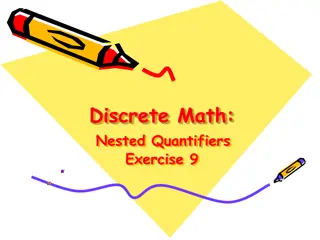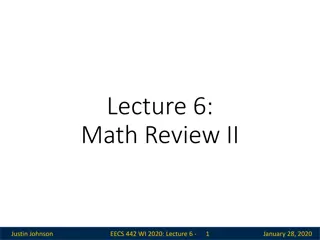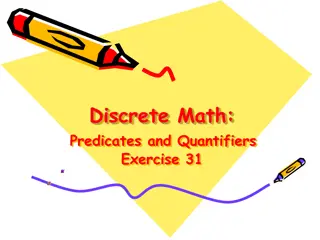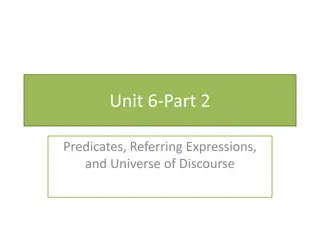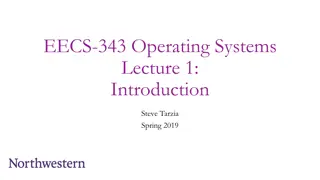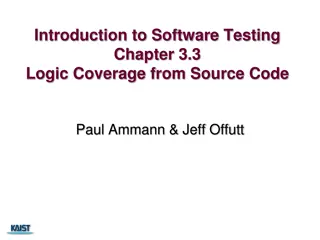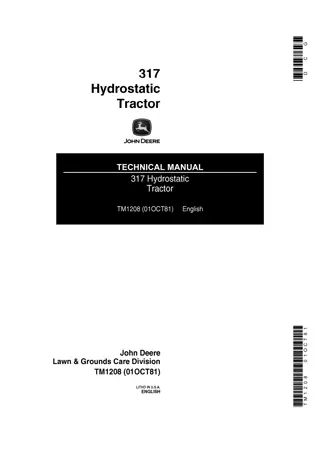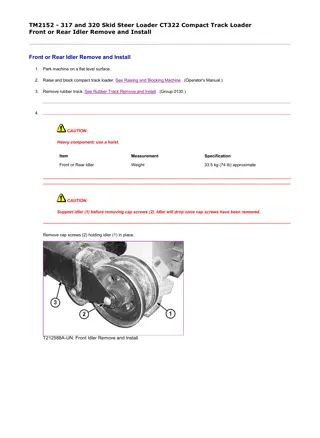
Advanced Data Management Techniques for Database Queries
Explore advanced SQL techniques such as combining SELECT statements, using predicates, and different types of JOINs like INNER, LEFT, CROSS, as well as UNION, INTERSECT, and EXCEPT to efficiently manipulate and process data in databases during EECS-317 lectures.
Download Presentation

Please find below an Image/Link to download the presentation.
The content on the website is provided AS IS for your information and personal use only. It may not be sold, licensed, or shared on other websites without obtaining consent from the author. If you encounter any issues during the download, it is possible that the publisher has removed the file from their server.
You are allowed to download the files provided on this website for personal or commercial use, subject to the condition that they are used lawfully. All files are the property of their respective owners.
The content on the website is provided AS IS for your information and personal use only. It may not be sold, licensed, or shared on other websites without obtaining consent from the author.
E N D
Presentation Transcript
EECS-317 Data Management and Information Processing Lecture 6 Combining SELECTs, Advanced Predicates Steve Tarzia Spring 2019
Announcements Second HW assignment due Monday night. HW1 solutions will be posted soon. Additional practice homework is posted in files section of Canvas. (Will not be graded.)
Last Lecture: OUTER and CROSS JOINs Introduced different types of JOINs: INNER (default): prints all pairs of rows (one from first table, one from second table) that satisfy the JOIN predicate. LEFT: same as INNER, but adds rows from LEFT table that never satisfied the JOIN predicate. LEFT with exclusion: only print rows from left table that never satisfied the JOIN predicate. CROSS JOIN: print the cartesian project, meaning all rows from the first table combined with all rows from the second table. There is no ON to match rows.
UNION, INTERSECT, and EXCEPT are used to combine two SELECT statements UNION prints rows from either of two SELECTs (printing duplicates just once) INTERSECT prints rows present in both SELECTs EXCEPT prints rows present in one SELECT but missing from another SELECT
JOIN vs. UNION JOINs combine tables horizontally. Match rows from two tables based on one or more columns matching. Creates a wider set of rows, adding columns from both tables. JOIN: UNION, INTERSECT, and EXCEPT combine result tables vertically Number & type of columns in the two result tables must match Changes the number of rows, not columns UNION:
Details of combining SELECTs UNION, INTERSECT, and EXCEPT all combine the results of two SELECT statements. UNION is the simplest, it just prints all rows from both: SELECT UNION SELECT Duplicates are printed just once. Each SELECT statement gets data from a different set of tables, otherwise it would be easier to just use a WHERE clause (with AND). Left and right SELECT queries must return the same number of columns, and the matching columns must have compatible data types. For example: list names of all the Customers and Employees: SELECT CustFirstName FROM Customers UNION SELECT EmpFirstName FROM Employees
Misuses of UNION, INTERSECT, and EXCEPT Two SELECTs are not necessary if you can get an answer from just one virtual table. SELECT * FROM Staff WHERE name="Jane UNION SELECT * FROM Staff WHERE name="John ; simplify to: SELECT * FROM Staff WHERE name="Jane" OR name="John ; SELECT * FROM Student_Schedules NATURAL JOIN Students EXCEPT SELECT * FROM Student_Schedules NATURAL JOIN Students WHERE Grade IS NULL; simplify to: SELECT * FROM Student_Schedules NATURAL JOIN Students WHERE Grade IS NOT NULL;
Display missing types of recipes (1 row) SELECT RecipeClassDescription, SUM(RecipeID IS NOT NULL) AS RecipeCount FROM Recipe_Classes LEFT NATURAL JOIN Recipes GROUP BY RecipeClassID HAVING RecipeCount = 0; or SELECT RecipeClassDescription FROM Recipe_Classes WHERE RecipeClassID NOT IN (SELECT DISTINCT RecipeClassID FROM Recipes); or SELECT RecipeClassID FROM Recipe_Classes EXCEPT SELECT DISTINCT RecipeClassID FROM Recipes;
Predicates in more detail WHERE & HAVING filter rows according to conditions called predicates. Any of the following can be combined, like an algebraic expression: Binary operations (used between two things): = != > < >= <= LIKE AND OR REGEXP (coming soon!) + - * / || % << >> & | NOT IS NULL, IS NOT NULL BETWEEN AND IN ( , , ) ( ) Can also use all of the above in the columns we print out, and inside aggregations likeSUM, MIN, MAX, AVG
Summing an indicator variable Two ways to count recipes with salsa in description: SELECT COUNT(*) FROM Recipes WHERE RecipeTitle LIKE "%salsa% ; WHEREclause keeps just the rows matching salsa, then these rows are counted. SELECT SUM(RecipeTitle LIKE "%salsa%") FROM Recipes; A column is created for every recipe indicating whether its title matches salsa or not. Column s value will be 1 if it matches and 0 if not. Sum of all the ones and zeros will be the count of matching recipes. First approach is easier to understand, but second is shorter.
CASE conditional Many programming languages have if then else expressions. SQL s equivalent is CASE: CASE WHEN THEN ELSE END Condition after WHEN is checked for true/false (1/0) If the condition is true, then the expression after THEN is used Otherwise (if the condition is false), then the expression after ELSE is used For example, print firstName for children or Mr/Ms lastName for adults: SELECT CASE WHEN age<18 THEN firstName ELSE (CASE WHEN gender="male" THEN "Mr. " ELSE "Ms. " END || lastName)END FROM people;
CASE in more detail WHEN condition is tested for every row, giving true or false SELECT CASE WHEN CategoryID=2 THEN "Bike" ELSE ProductName END FROM Products; If condition is true then use the first value. Output: If condition is false then use the second value.
Another CASE example Let s say we want to print sale prices for products that are overstocked. Any products with 20 or more items in stock are discounted 25%, but other products remain at regular retail price. SELECT ProductName, QuantityOnHand, RetailPrice, CASE WHEN QuantityOnHand >= 20 THEN 0.75*RetailPrice ELSE RetailPrice END AS SalePrice FROM Products;
CASE can also be used in filters Print customers named Martin but refer to the first name in the friendly state of California and the last name elsewhere. SELECT * FROM Customers WHERE CASE WHEN CustState = "CA" THEN CustFirstName ELSE CustLastName END = "Martin"; Incidentally, this is equivalent to: SELECT * FROM Customers WHERE (CustState = "CA" AND CustFirstName = "Martin") OR (CustState != "CA" AND CustLastName = "Martin");
Tell me if each recipe is vegetarian, and if not, then name the meat ingredient. SELECT (RecipeTitle || CASE WHEN IngredientName IS NULL THEN " is vegetarian" ELSE " is not vegetarian because it contains " || IngredientName END || ".") AS announcement FROM Recipes LEFT NATURAL JOIN (SELECT * FROM Recipe_Ingredients LEFT JOIN Ingredients ON Recipe_Ingredients.IngredientID=Ingredients.IngredientID WHERE IngredientClassID IN (2,10)); Print a different message for veg/meat recipes LEFT JOIN with a table printing only the meat/seafood recipe steps Meat or seafood *Note that a NATURAL JOIN cannot be used between Recipe_Ingredients and Ingredients because they have two columns in common (IngredientID and MeasureAmountID) and MeasureAmountID does not always match.
The result: Could change the query to eliminate this duplication.
Recipes: Print every pair of recipes and the number of ingredients they share in common SELECT r1.RecipeTitle, r2.RecipeTitle, COUNT(i2.IngredientID) AS common_ingredients FROM Recipes AS r1 CROSS JOIN Recipes AS r2 JOIN Recipe_Ingredients AS i1 ON r1.RecipeID = i1.RecipeID LEFT JOIN Recipe_Ingredients AS i2 ON r2.RecipeID = i2.RecipeID AND i1.IngredientID=i2.IngredientID GROUP BY r1.RecipeID, r2.RecipeID HAVING r1.RecipeID < r2.RecipeID ORDER BY common_ingredients DESC;
Show me all ingredients and any recipes theyre used in (108 rows) SELECT IngredientName, RecipeTitle FROM Ingredients LEFT JOIN Recipe_Ingredients ON Ingredients.IngredientID=Recipe_Ingredients.IngredientID LEFT NATURAL JOIN Recipes;
Recap UNION, INTERSECT, and EXCEPT Used to combine two SELECT statements. Combines results table vertically (rather than horizontally for JOINs) Necessary when answer requires two different (virtual) tables. Discussed more advanced uses of predicates. Summing an indicator variable. Introduced CASE statement which chooses between two different options depending on some condition in the row.





